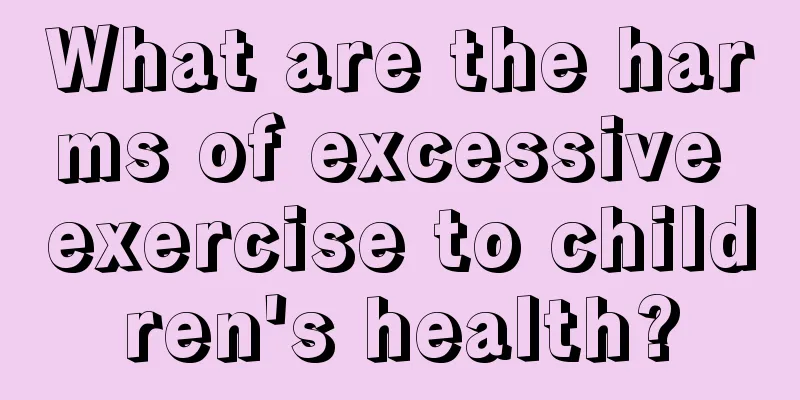Symptoms of roseola in babies

|
Babies' skin is very delicate and can easily become allergic or develop rashes if not handled with care. Baby roseola is actually a rash on the baby's body. It looks densely packed, all over the body, and looks rose red, so many people say that this is baby roseola. Babies need to be treated promptly after they develop roseola. What are the symptoms of baby roseola? Roseola infantum, also known as roseola infantum, is an acute benign roseola-like eruption in infants and young children, characterized by the appearance of the rash after the fever subsides. It is usually seen on the neck, upper trunk, face and limbs. It generally does not occur on the nose, cheeks, below the knees, and palms and soles, and the systemic symptoms are mild. The child's general condition is good. In addition to high fever and poor appetite, a few children may experience fatigue, nausea, swollen cervical lymph nodes and convulsions during the fever period. This disease can be diagnosed in children under 2 years old who suddenly develop high fever without rash, but develop a rash when the fever subsides. Roseola infantum may be virus-related, and some believe it is caused by Coxsackievirus B5. But definitive evidence is lacking. This disease mostly occurs in children under 2 years old and is more common in winter. The incubation period is 10 to 15 days. Sudden high fever without any previous symptoms, with body temperature as high as 39-40℃. After 3 to 5 days, the body temperature drops sharply, and at the same time, light red millet-sized maculopapules appear on the skin, which are scattered and a few rashes merge into patches. The rash will appear after 24 hours, and disappear after 1 to 2 days without leaving any trace. The incubation period of this disease is 7 to 17 days, with an average of about 10 days. The onset is acute, with a fever of 39 to 40 degrees. High fever may be accompanied by convulsions in the early stages. The patient may have a mild runny nose, cough, and swollen eyelids. Conjunctivitis, during the fever period there are symptoms such as poor appetite, nausea, vomiting, mild diarrhea or constipation, mild congestion of the pharynx, enlarged lymph nodes in the occipital area, neck and behind the ears, the body temperature persists for 3 to 5 days and then drops suddenly, when the fever subsides, light red macules or maculopapules of varying sizes appear, which fade when pressed, initially starting on the trunk and quickly spreading to the whole body, with more cases on the waist and buttocks, the rash disappears in 1 to 2 days, without pigmentation or desquamation. The enlarged lymph nodes subside later but are not tender. During the course of the disease, the number of peripheral blood white blood cells decreases, and the lymphocyte classification count can reach 70% to 90%. The diagnosis is mainly based on clinical features, age of onset and season of onset, including the following: 1. Sudden onset of high fever, while other clinical symptoms are relatively mild. 2. Swollen and tender lymph nodes in the neck, occipital area, and behind the ears. 3. The peripheral blood white blood cell count is decreased, and the lymphocyte classification count is high. 4. The age of onset is less than 2 years old. |
<<: Alcohol or iodine for the umbilical cord of a newborn
>>: What to do if a two-year-old baby has hemorrhoids
Recommend
Is it normal for a newborn to snore?
Snoring has another alias, which is snoring. Norm...
What should I do if children cough in the evening or morning?
Children are prone to coughing at night and in th...
What to do if a one-month-old baby has a fever of 37.7
The biggest headache for many young parents is th...
Height and weight standard for 6-year-old children
When a woman becomes pregnant, she should go to t...
What to do if a boy has inverted nipples
When we talk about inverted nipples, we often thi...
Causes of children's coughing and vomiting
Coughing in children is a relatively common disea...
What to do if a newborn baby spits up milk from his nose
There is a method to feed a baby. If parents do n...
What should a 5-year-old learn?
As children grow up, their intelligence gradually...
Baby sleeping
If a baby who is less than one month old makes gr...
My baby's first deciduous tooth is crooked
Deciduous teeth are quite important for babies. I...
Why does a 10-month-old baby sweat while sleeping?
When babies are just born, their resistance is no...
Symptoms of rhinitis in a three-year-old child
Rhinitis is most of the time a disease caused by ...
How many months does it take for a baby to have normal teeth?
Every stage of the baby's growth is very impo...
What should I do if my child’s skin is broken and becomes inflamed? Should he take anti-inflammatory drugs?
Children are particularly naughty, so some of the...
Baby wakes up once an hour at night
Some babies are particularly easy to wake up when...









